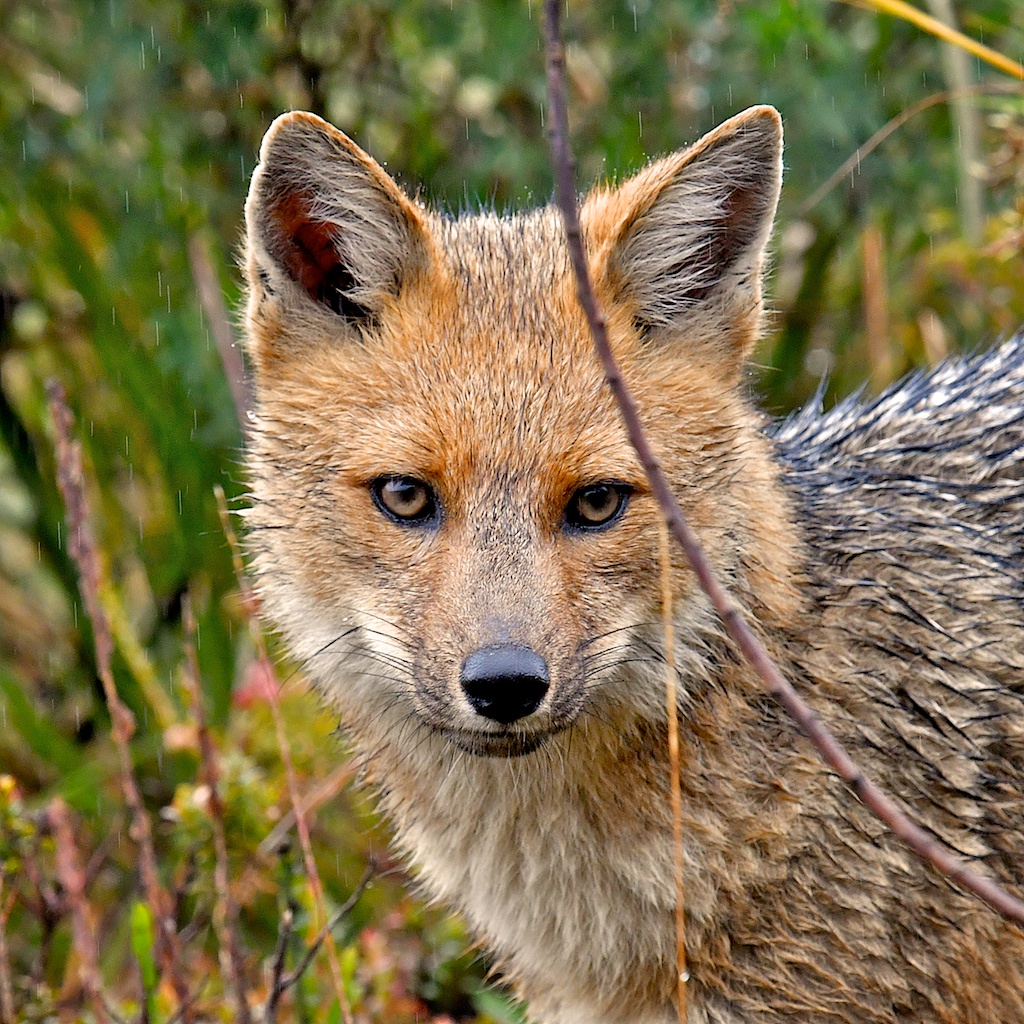
Ecuador January 2018 (Spectacled Bear, Olinguito)
Ecuador 8th – 20th January 2018 (plus transit stop in Florida, USA, 21st January)
The main target of this trip to the Andes was Spectacled Bear, plus hoped-for Olinguito and Mountain Tapir. Participants were (UK) Phil Telfer, Karen Baker, John Wright, and (USA) Charles Hood.
Hood is submitting this report: hoodcw (at) gmail (dot) com.
We had mixed success and mixed weather; others planning this route might not want to do it in January, which seems less good for visibility in the Andean high country. (By “less good” I mean there were entire days when one saw nothing but clouds and rain. For the foothill site of San Isidro, in a 47-hour visit, it rained 42 of those hours.) We saw a total of either 5 or 8 Spectacled Bears, probably the same Olinguito over several nights, and some unexpected but good small stuff. We tried to arrange for bat netting but had no luck in finding somebody with interest / permits.
Travel in Ecuador is simple and hassle-free, as is arrival at the airport. Having some basic Spanish helps everywhere. We used taxis and pre-arranged shuttles rather than having a self-drive hire car; that was probably the best choice, though costs probably would have been the same either way. Oddly, we all four came down with travel bugs, even though between us we’ve made 100+ trips abroad, and it is also true that due to winter coughs, at times we sounded like escapees from the tuberculosis ward.
In chronological order, we visited….
(1) Maquipucuna (“M” on the lists) 8th January
CH only, 1 night, reached in 2 hours from the airport via pre-arranged transfer ($130, one-way, which seems too high). From late-November to late-December, this might be the best place in the world to see Spectacled Bear, since they come down to the lodge area then to eat wild avocados. It is less interesting at other times; main lodge is in mid-elevation second growth and unless one is a beginning birdwatcher, doesn’t have a lot to offer. Pleasant grounds and fine staff but unless the bears are showing, not an essential stop. It would though be good for bat netting?
(2) Bellavista near Mindo (“B” on the lists) 9th – 12th January
4 nights, and this is the famous Olinguito site. For neotropical birding, it ranks very high as well. Owner / manager Richard can be very helpful in arranging rides / guides. The greater Mindo area has a cottage industry of local landowners who make garden features on their property and via bananas, attract multiple tanagers, Kinkajous, and (supposedly) Tayras. The only garden that may really have a regular Tayra is Pacha Quindi Hummingbird Garden, owned by Tony and Barbara Nunnery. It is unmarked (!), 1.5 km downhill from Bellavista. In four days of watching at this site and others, for periods of 1 to 4 hours, we had one Tayra sighting for about 10 seconds. Yet one hears reports of galloping herds of these beasts, so maybe we had bad luck.
We missed Oncilla at Bellavista (and everywhere else) and also missed Mountain Coati. See notes on misses at end of main list.
This may be the only site in the world for Tube-lipped Tailless Bat? It takes good photos to be certain of ID, but a few come to the hummingbird feeder by the gift shop / office about an hour after sunset and feed for 1-2 hours, then seemingly go elsewhere. We had Olinguito 2 of 4 nights, and a clear view of Andean White-eared Opossum on 1 of 4 nights; it seems less common than previously reported. We did trap here; see notes on trapping below. We also did night drives, but as was true at all sites on this trip, we saw absolutely nothing. Total for several hours might be a few nightjars, two village cats, and a frog.
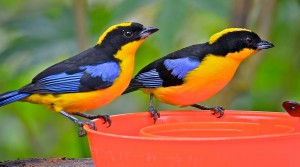
As a birding destination, Bellavista is a must-do site; do note that it does not have wi-fi (though Richard has a laptop for guest use; important to me, since I needed to work most days). Note as well that accommodations are not very insulated and so you can hear everything in the adjacent rooms, including if somebody snores in the room next door, takes a middle-of-the-night wee in the room above, or goes up and down the exterior stairs in anything other than stealth Ninja mode. Good food and good scenery, but rooms can be frustratingly un-quiet. Upper floor rooms may be better than lower ones. (It is better to give than to receive, in the noise department.)
(3) Guango (“G” on the lists) 13th January
1 night. A mid-altitude lodge whose rooms have a sort of hobbit hole or “inside of a submarine” feel; it seems a popular site with German, Swiss, and Danish birders? We stayed here one night and did a day visit a second time from Papallacta (it’s under a 20 minute drive from Papallacta). Normally it is good for Mountain Tapir (or so we were told) but construction on an adjacent pipeline seems to have driven them into the forest. The rabbit here is darker than elsewhere with a very rufous hind-neck. Look for them on the trail down to the Torrent Duck viewing area on the river. Otherwise, other than scenery (the trail along the river looks a bit like hiking around Anchorage, Alaska), not an essential stop…not unless the tapirs are showing, in which case count your blessings and do the happy dance. For us, the rain started here and lasted the rest of the trip.
(4) San Isidro (“SI” on the lists) 14th – 15th January
2 nights. Another beautiful site and it now has new rooms (ask for Cabin 1 or 2), a new dining room, and trails that when we were there were mostly closed or in very slick condition. We had high hopes but limited results. One person (JW) finally saw a Mountain Tapir, but the expected Black Agoutis are not on site presently. The US bird company Field Guides bases itself here for a November tour, and for birding, in good weather, I can see why this is a premium destination. We did locate the famous “San Isidro Owl” whose taxonomy baffles the experts. Snappy looking creature but I would have traded 10 owls for one Black Agouti.
Unlabeled photos here via CH. View of the Andean high country:
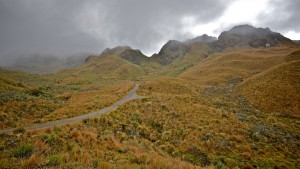
(5) Papallacta (“P” on the lists) 16th – 19th January
4 nights and we stayed at the upscale Termas Hotel, with heated chalets organized around a series of thermal wading pools that were drained and filled randomly—supposedly for cleaning, but mostly just to confuse the tourists it seems. Nice place: it reminded me of the Sheraton my wife and I stayed in in Hawaii on our honeymoon. There is no meal plan and prices in the on-site restaurant are European / US high, so be warned about that. Leaving the compound and walking downslope towards the plebian part of the village takes one to mom-and-pop restaurants whose prices are 70% lower than the resort’s. The Cayembe-Coca Natural Park was, for us, the place to find Spectacled Bears and we weren’t disappointed. We used the services of the famous bear guiding brothers Patricio and Mario who receive our highest endorsements; they can arrange visits to all parts of the surrounding paramo habitat in the park. Patricio and Mario know the sites better even than park rangers, and were prompt, safe drivers. Contact pillajomario@yahoo.co. It was not their fault that the weather most days was a mix of icy drizzle and pea-soup cloudiness. Mario can whistle like a tapir, not that anybody seems to have told the tapirs that.
This area is well-known for thermal pools. Phil T claims he was looking for tapirs but if so, where are his binoculars?
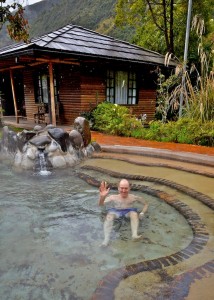
Trapping results
We brought bait and Sherman traps. As expected, results were grim. Contrary to the Southern California deserts, where one can put out 10 traps and have 10 hits within the first hour, we had almost nothing everywhere we went.
Bellavista = 10 traps along the H Trail, starting at the compost bins = 2 hits only, both of the same species, Alfaro’s Rice Rat. (Who was Alfaro? Poet and naturalist who founded the national museum in Costa Rica. Lived to be 90 and has ants named after him too.)
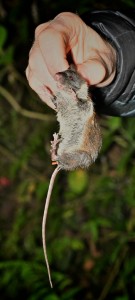
Guango = 10 traps; 4 on the kitchen side of the lodge and 6 in the hummingbird garden and car park area. No hits.
San Isidro = 4 traps near Cabin 2. No hits.
Papallacta = 8 traps on the Termas Hotel grounds, no hits, and 10 traps in the forest, also no hits.
USA Stopover
On Saturday 20th January in the late afternoon CH flew back to the USA, while PT, KB, & JW had a late night flight to Miami, USA, arriving early on Sunday 21st. We made use of a long transit stop in Miami (15 hours) to head out to the Everglades and look for Manatees. We had a boat trip booked from Port of the Islands Resort with http://www.see-manatees.com and were already seeing Manatees in the harbour before the boat departed. The tour was fine with plenty of Manatees but the clarity of water wasn’t good and a research boat seemed to be making the animals more difficult to approach than usual. Driving back to Miami along route 41 we stopped off on the right at the Big Cypress National Preserve Welcome Centre. There was a boardwalk behind this overlooking the water and there were several Manatees here as well giving quite close views, so this could be an easier option than going out on a boat. While we were pleased to see some Manatees, the clear water of somewhere like Crystal River would give much better views but we didn’t have time for this. It was a really good day though and great to get into some warm weather after two weeks in Ecuador. [Note from CH: I have had reports of bobcat right on the boardwalk at Big Cypress.]
Species list
M = Maquipucuna
B = Bellavista
G = Guango
SI = San Isidro
P = Papallacta
Andean White-eared Opossum Didelphis pernigra B
Seen well one night, glimpsed one other time as well.
Linnaeus’ Mouse-Opossum Marmosa murina B
Seen well one night by birders; we followed their directions and saw it much less well ourselves the following night.
Dusky Shrew-Opossum Caenolestes fuliginosus P
Two seen briefly on a night drive in the national park above Papallacta village. Supposedly common.
Tapiti (Andean Rabbit) Sylvilagus andinus G, SI, P
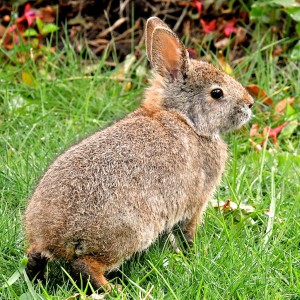
In splitting this species we follow Mammals of Ecuador and a recent article in Journal of Mammalogy.
Red-tailed Squirrel Sciurus granatensis M, B, G, SI
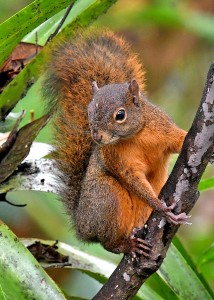
Common and cute. Bogarts bananas at the feeders.
Andean Forest Mouse Chilomys instans B
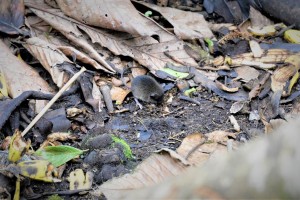
(( Photo by PT )) A sort of white-footed mole-like thing under the bananas at Bellavista that did a lemming’s suicide dive off a small ledge once CH arrived. His students often exhibit parallel behavior.
Alfaro’s Rice Rat Handleyomys alfaroi B
Two trapped at Bellavista; has other common names (like forest mouse).
Broad-footed climbing mouse Rhipidomys latimanus M
Seen by CH on a night walk. I knew there was a reason I brought so many spotlights.
Colpeo Fox Lycalopex culpaeus P
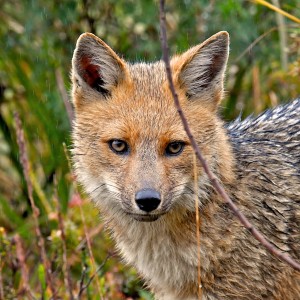
A very obliging single seen on two days. May respond to squeaking.
Spectacled Bear Tremarctos ornatus P
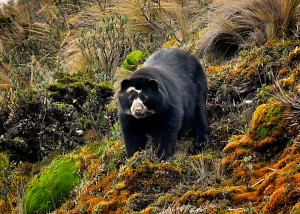
The highlight of the trip. A female with 2 cubs seen on the afternoon of the 16th, a single adult also on the 16th, a female with 2 cubs on the 17th was probably the same as on the 16th but was quite a few kilometres apart from the first sighting, a single adult on the 19th was definitely different from the single adult seen on the 16th (face pattern/spectacles). So definitely 5 bears seen, just possibly 8. Here Phil celebrates in a moderately restrained British sort of way.
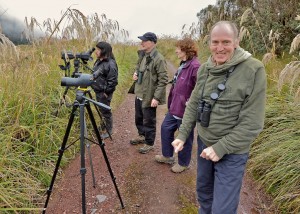
Olinguito Bassaricyon neblina B
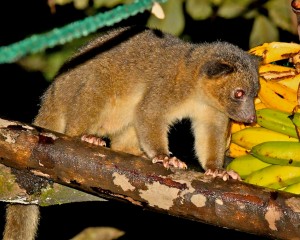
2 nights out of 4 coming to bananas by dining room, Bellavista. May have been around more than we saw; we were doing night drives and listening to the snoring of adjacent rooms, so did not monitor the trees all night long. A Japanese film crew was here too; we may all be tv stars some day. More or less looked like any other olingo to me, but I am sure it is Very Special.
Kinkajou Potos flavus B
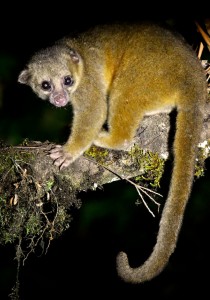
Bellavista and the garden of Mr. Vinicio Perez, Mindo.
Long-tailed Weasel Mustela frenata P
KB saw one cross the track, Papallacta area.
Tayra Eira barbara B
1 seen in the bottom garden of property owned by Tony Nunnery (who is a VENT leader); NOT in the garden of Mr. Vinicio Perez, Mindo.
[ Striped Hog-nosed Skunk Conepatus semistriatus ] P
Roadkill, mentioned here just for completeness. Never seen on any night drives.
Black Myotis Myotis nigricans M
Seen and bat-detector’d by CH. Right altitude / habitat.
Andean Brown Bat Eptesicus andinus G
Seen and partially bat detector’d at Guango in the clearing below the lodge where they have a white panel and light for attracting insects. Right altitude / habitat; bat detector said it was some kind of brown bat, but we did not net it or have it in-hand. Seems right though.
Mexican Free-tailed Bat Tadarida brasiliensis SI
Seen and bat-detector’d by CH. Right altitude / habitat. Common.
Northern Ghost Bat Diclidurus albus SI
Seen and bat-detector’d by CH but not in Mammals of Ecuador for this site. Seems right though.
Tube-lipped Tailless Bat Anoura fistulata B
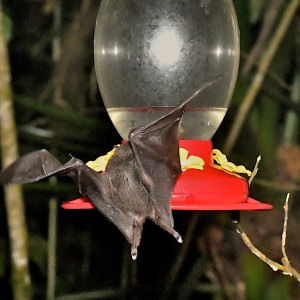
ID tricky so plan on taking a lot of photographs (and bringing a fast lens). It helped that we could split up the team: some to monitor feeders while others watched for Olinguito at the bananas.
Silky Short-tailed Bat Carollia brevicauda M
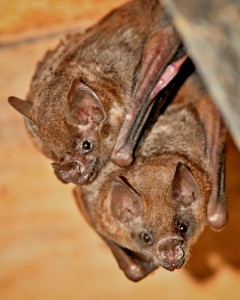
Roosting in the storage area beneath the biology field station, Maquipucuna.
Common Squirrel Monkey Saimiri sciurreus SI
An hour downhill from San Isidro on the road to Tena is a vacation village called Orchid Paradise Hotel which has a large group of habituated squirrel monkeys. In theory capuchins and wooly monkeys are possible there too, though under what circumstances, it was not clear. This species complex may be split some day?
White-tailed Deer Odocoileus virginianus peruvianus P
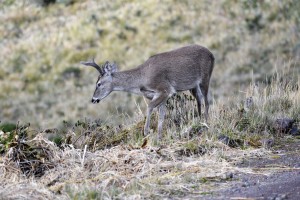
(( Photo by PT )) Singletons seen around Papallacta plus at least one roadkill. This is part of a potential split?
Mountain Tapir Tapirus pinchaque SI
San Isidro puts out salt; waiting from late afternoon to dusk (well-hidden) did not get us this species; CH started checking the salt at dawn, missed it, but then JW got one yet couldn’t find anybody else to share in the prize because everybody else was sick or looking for Black Agouti. At the right time could have been easy at Guango and possible at Papallacta, where sometimes they are even seen downhill from the hotel. PT did not need it, leaving KB and CH to hate JW forever.
USA, Florida excursion
Caribbean Manatee Trichechus manatus
At least 20 seen on our boat trip with a further 5 seen from the boardwalk at Big Cyprus National Preserve.
Notes on misses (alphabetical)
bats “spp”
At Maquipucuna, Guango, and San Isidro the bat detector had lots of activity that it could not identify. CH uses an Echo Meter Touch 2 Pro and an iPhone. I do not try to use software to analyze the calls after the fact (that seems like a good project for when I retire). For now, bats are just an endless stream of question marks in my field notes.
Black Agouti
Used to come to hummingbird feeders / garden at San Isidro. We checked grounds and trails at night, at dawn and dusk, during the day—checked nonstop, basically. Had zero luck.
Mountain Coati
Supposed seen at gardens around Mindo. We paid to wait all morning at such a site; nothing. Birders at Bellavista had seen them. CH found tracks at Bellavista on the D Trail.
Oncilla
Reports from night drives at Bellavista; reports from camera traps and in-person around lodge as well at Bellavista. Camera trapped at Guango and San Isidro. They are out there—somewhere.
Pampas Cat
Guides at Papallacta basically said, “Get real, dudes.” One on a camera trap at Guango.
porcupines “spp”
Lots of reports over the years, but nothing for our team. Maybe we need thermal scopes?
Puna Deer
Possible at Papallacta but never seen.
Insects of Ecuador
Ecuador has many interesting moths, butterflies, and other insects. Unfortunately some come with birds stuck to the ends of them.
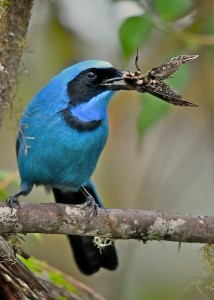
Oh well, no place is perfect.
4 Comments
-
Michael
Cool report! I’ll be going to Ecuador next year and will try to catch up with some of the species I am missing, especially the Tapir and the Caenolestes, which would be a new family for me.
Just a comment on the coatis at Bellavista: I have seen definitely South American Coatis there. I have seen and photographed Mountain Coati higher up at Yanacocha reserve. Actually, both sightings were on the same day and the differences were obvious. So don’t assume that every coati at Bellavista is a mountain one…
Leave a Reply
You must be logged in to post a comment.


geomalia
I missed the Bears by 2 days at Maquipucuna in December! I did see a few nice opossums (including Marmosa phaea) and some glass frogs, but it was a little frustrating. I’ve seen the bears at Papallacta, but wanted better views and photos (especially given my website url…). I’ll post a report of my own next month. I just visited two sites – Maquipucuna and Shiripuno.
Great shot of the Culpeo!
As for the Tapir at Guango, one individual was being seen regularly for a couple weeks late last year, but I don’t think it’s normally good for them.
Ben
http://www.tremarctos.com